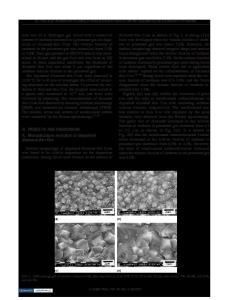Chemical influence of inert gas on the thin film stress in plasma-enhanced chemical vapor deposited a -SiN: H films
- PDF / 274,552 Bytes
- 8 Pages / 612 x 792 pts (letter) Page_size
- 56 Downloads / 354 Views
MATERIALS RESEARCH
Welcome
Comments
Help
Chemical influence of inert gas on the thin film stress in plasma-enhanced chemical vapor deposited a-SiN : H films M. J. Loboda and J. A. Seifferly Dow Corning Corporation, Midland, Michigan 48686–0994 (Received 26 April 1995; accepted 13 October 1995)
The growth of amorphous hydrogenated silicon nitride (a-SiN : H) films by plasma enhanced chemical vapor deposition (PECVD) of SiH4 –NH3 –N2 reactive gas mixtures has been studied. Films were deposited at low temperature (T , 250 ±C) in a commercial PECVD system commonly used to grow a-SiN : H for semiconductor integrated circuit passivation. It has been observed that the stress of the a-SiN : H film can be controlled through dilution of the film precursors with an inert gas. Experiments indicate that the influence of the inert gas on the process extends from growth kinetics and plasma chemistry to hydrogen bonding, elemental composition, and biaxial elastic modulus. The stress in films deposited without dilution is tensile. When argon is added to the plasma, Si–Hx plasma chemistry and film hydrogen bond density change producing a reduction in the amount of tensile stress. Dilution with helium can be used to shift the film stress from tensile to compressive with minimum change in growth rate. The observed helium/film stress relationship is associated with helium-based Penning ionization processes, which create metastable reactive gas species. In turn, the metastables influence nitrogen and hydrogen incorporation into the film. Nitrogen incorporation produces volume expansion of the film, increasing the compressive character of the film stress. This effect is similar to that observed when the RF power is varied or when low or multifrequency plasma excitation is used during PECVD growth of a-SiN : H.
I. INTRODUCTION
The semiconductor integrated circuit industry currently relies on low temperature (T , 400 ±C), plasma deposited, amorphous hydrogenated silicon nitride films (a-SiN : H) for the passivation and protection of integrated circuits (IC). Plasma silicon nitride is known as an effective moisture and ionic contamination barrier. The growth process-film property relationships for this material have been studied extensively. Of the many key properties measured on a-SiN : H films, film stress receives much attention. When used as a passivation layer, the performance of the film is related to film stress. High tensile stress results in cracking of the film, while high compressive stress can result in peeling. With the decrease of the line widths of aluminum interconnections to below 1 mm, film stress in the passivation has been linked to IC reliability problems such as the formation of voids and hillocks in the metallization and electromigration.1,2 Stress in silicon nitride films will vary depending on the deposition process conditions. Source gas (mixtures of SiH4 , NH3 , and/or N2 ) composition,3–6 RF power,3,6 and plasma excitation frequency7–9 have been shown to influence the stress in a-SiN : H films over a broad
Data Loading...











